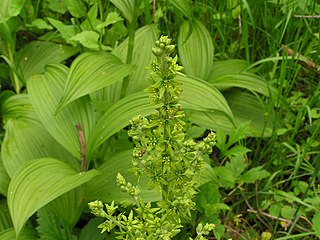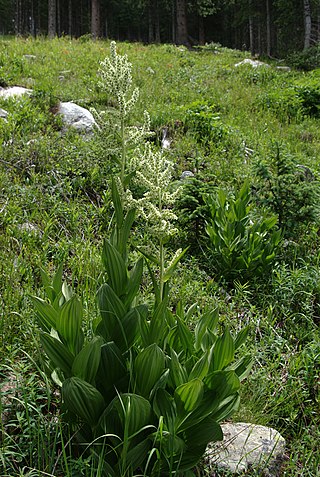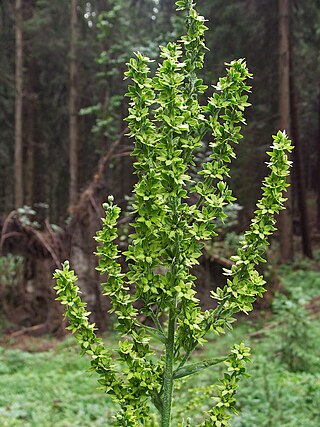
Melanthieae is a tribe of flowering plants within the family Melanthiaceae. Molecular phylogenetic studies in the 21st century have resulted in a large-scale reassignment of many of its species to different genera; in particular the genus Zigadenus (deathcamases) has been restricted to a single species, Zigadenus glaberrimus. Plants contain alkaloids, making them unpalatable to grazing animals; many are very poisonous to both animals and humans.

Veratrum viride, known as Indian poke, corn-lily, Indian hellebore, false hellebore, green false hellebore, or giant false-helleborine, is a species of Veratrum native to eastern and western North America. It is extremely toxic, and is considered a pest plant by farmers with livestock. The species has acquired a large number of other common names within its native range, including American false hellebore, American white hellebore, bear corn, big hellebore, corn lily, devil's bite, duck retten, itchweed, poor Annie, blue hellebore and tickleweed.
False helleborine is a name is used in different parts of the world to describe several different plants of either the Orchid family or the Lily family.

Veratrum is a genus of flowering plants in the family Melanthiaceae. It occurs in damp habitats across much of temperate and subarctic Europe, Asia, and North America.

Star lily or starlily is a common name for several plants and may refer to:

Veratrum album, the false helleborine, white hellebore, European white hellebore, or white veratrum is a poisonous plant in the family Melanthiaceae. It is native to Europe and parts of western Asia.

Allium moly, also known as yellow garlic, golden garlic and lily leek, Is a species of flowering plant in the genus Allium, which also includes the flowering and culinary onions and garlic. A bulbous herbaceous perennial from the Mediterranean, it is edible and also used as a medicinal and ornamental plant.

Veratrum californicum is an extremely poisonous plant native to western North America, including the Sierra Nevada and Rocky Mountains, as far north as Washington and as far south as Durango; depending on latitude, it grows from near sea level to as high as 11,000 feet. It grows 1 to 2 meters tall, with an erect, unbranched, heavily leafy stem resembling a cornstalk. It prefers quite moist soil, and can cover large areas in dense stands near streams or in wet meadows. Many inch-wide flowers cluster along the often-branched top of the stout stem; they have 6 white tepals, a green center, 6 stamens, and a 3-branched pistil. The buds are tight green spheres. The heavily veined, bright green leaves can be more than a foot long.

Trillium stamineum, the twisted trillium, also known as the Blue Ridge wakerobin, is a species of flowering plant in the family Melanthiaceae. It is native to the southeastern United States, in Alabama, Mississippi and Tennessee. Its natural habitat is calcareous woodlands.

Vaccinium stamineum, commonly known as deerberry, tall deerberry, highbush huckleberry, buckberry, and southern gooseberry, is a species of flowering plant in the heath family. It is native to North America, including Ontario, the eastern and central United States, and parts of Mexico. It is most common in the southeastern United States.

Melanthium is a genus of herbaceous perennial plants native to North America. They are closely related to Veratrum, and in fact are included in that genus by some authors. The distinction between Melanthium and Veratrum is based on various morphological traits, but it is not yet clear where the line is best drawn.

Mount Yakushi is one of the 100 Famous Japanese Mountains, reaching the height of 2,926 m (9,600 ft). It is situated in Japan's Hida Mountains in Toyama Prefecture. It was specified for Chūbu-Sangaku National Park on December 4, 1934.

Veratrum hybridum is a species of flowering plant in the Melanthiaceae known by the common names slender bunchflower and crisped bunchflower. Many publications use the synonyms Melanthium latifolium and Veratrum latifolium, but the "hybridum" epithet is 9 years older than the "latifolium," so Veratrum hybridum is now the accepted name.

Steroidal alkaloids have the basic steroidal skeleton with nitrogen-based functional groups attached to the skeleton. More specifically, they are distinguished by their tetracyclic cyclopentanoperhydrophenanthrene skeleton that marks their close relationship with sterols. They fall in two major categories: Solanum alkaloids and Veratrum alkaloids. A Steroidal alkaloid has also been found in Chonemorpha fragrans, 'chonemorphine' was used to treat intestinal infections in Wistar rats..
Allium rupicola is a species of onion found in Israel, Turkey, Lebanon and Syria. It has a rosette of leaves plus a scape bearing an umbel of pink flowers.
Allium decaisnei is a species of onion found in Israel, Palestine, Jordan, and the Sinai Peninsula in Egypt. It is a perennial with an upright scape. Umbel is loose, with long-pediceled green flowers, most of them nodding (drooping).
Cyclotrichium is a genus of plants in the Lamiaceae, first described as a genus in 1953. The entire genus is endemic to southwestern Asia.
- Cyclotrichium depauperatum(Bunge) Manden. & Scheng. - western Iran
- Cyclotrichium glabrescens(Boiss. ex Rech.f.) Leblebici - southeastern Turkey
- Cyclotrichium haussknechtii(Bunge) Manden. & Scheng. - western Iran
- Cyclotrichium leucotrichum(Stapf ex Rech.f.) Leblebici - Iran, Iraq, Turkey
- Cyclotrichium longiflorumLeblebici - Iran, Iraq, Turkey
- Cyclotrichium niveum(Boiss.) Manden. & Scheng - eastern Turkey
- Cyclotrichium origanifolium(Labill.) Manden. & Scheng. - Lebanon, Syria, southern Turkey
- Cyclotrichium stamineum(Boiss. & Hohen.) Manden. & Scheng. - Iraq, Turkey
- Cyclotrichium straussii(Bornm.) Rech.f. - western Iran
Allium stamineum is a species of flowering plant in the Amaryllidaceae family. It is an onion found in the Middle East.

Amphilophium is a genus of flowering plants in the family Bignoniaceae, native to South America. Amphilophium crucigerum has escaped from cultivation elsewhere, and has become an invasive weed in Australia.

Veratrum lobelianum is a species of flowering plant belonging to the family Melanthiaceae.













